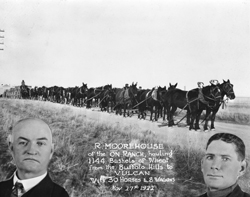The Last of the Big Freighters
 |
‘Slim’ Moorehouse’s (right) hitch of 32 mules and horses. Glen House (left) was Moorehouse’s sponsor for this hitch. It is believed that some of the outriders on this hitch and the ones to follow were Walter Ward, Clyde and Reno (Shorty) House, Jim Mooney, Ted Bartsch, Slim McDonald, Bill McColeman, Sam Brown and Robert Staggs. Don Brier was a rider, and the brakeman and spare driver of the 1925 hitch. |
Long after automobiles were invented, the grain wagons that rumbled across the prairie were the last of the horse-drawn vehicles to leave the road. Able to haul between 65 to 150 bushels of grain, the grain wagons were a staple on western farms and ranches and while progress was fast, trucks were unreliable and unable to haul equivalent loads. Besides, farmers had a lot of money invested in horses and wagons.
The largest commercial freight hauling company at the time was the I. G. Baker Company out of Fort Benton, Montana. Their long prairie trains of “bull” (oxen) teams were strung out for miles on their way to Calgary and Blackfoot Crossing. The oxen, plodding along at a little over one mile an hour, were pulling tons of freight on the heavy high-wheeled wagons. ‘Slow but Sure’ was their motto.
But there was one Alberta teamster who tried his hand at outdoing the Baker Company and all other comers, the legendary teamster, Ralph “Slim” Moorehouse. (In various archives and a search of the Prairie Hub history book, his last name has also been spelled Morehouse.) While working for Jim Dew on the ON Ranch in the Buffalo Hills of Alberta, Moorehouse had his eye on the big freight contracts, figuring that if he could deliver more grain at a faster pace, he would have the delivery market sewn up.
To put his plan into action, Moorehouse borrowed all but two horses and on November 22, 1922, the long line teamster hitched thirty head to eight grain tanks and hauled a record 1144 bushels of wheat in one load from the Buffalo Hills to the elevators in Vulcan. Next, he tried mules—hitching thirty for his grain haul. With five outriders to help hitch, keep the mules pulling evenly and to set the brakes when going down hills and to release them when they reached the bottom, (which they did without dismounting from their saddle horses), Moorehouse made another record trip.
 |
| Ralph ‘Slim’ Moorehouse and his 36-horse hitch of matched black Percherons in the 1925 Calgary Stampede parade. The eveners of the lead nine teams were hitched to one cable and the eveners of the nine wheel teams were hitched to another cable. When going around a corner, the wheel teams would step over the cable as it tightened, continuing to pull the wagons straight. One little known fact; the two outriders by the heads of the lead team had lengths of stovepipe wire attached to the bits, helping to guide the leaders around corners as Slim couldn’t see them. Another bit of little known trivia; they once hooked a fire hydrant with one of the cables while turning a corner, pulling it straight out of the sidewalk. Photos courtesy of Glenbow Archives |
The now famed teamster knew the writing was on the wall for the big freighters and that fall, he sold the mules to construction contractors working for the Alberta Railway and Irrigation Company. He was going to go out of the freighting business, but he was going out in style.
He secured financial backing from the Canadian Percheron Association and along with Chris Bartsch, spent 1925 scouring the surrounding districts for Percheron draft horses. The horses had to weigh at least 1600 pounds, be the same height and approximate build, and they all had to be black.
By the summer of 1925, he was ready. With some six outriders, Moorehouse and his helpers harnessed up the gleaming horses in matching harness supplied by T. H. Beach of Gleichen and drove the matched hitch of 36 draft horses in the Calgary Stampede parade. According to records, that year there was a parade every morning, and Moorehouse and his crew started early from the Stampede grounds, hitching up and driving the world’s biggest hitch down 7th and 8th Avenue every morning for a week. The hitch was viewed by visiting celebrities and residents alike. Small bags of Marquis Wheat, grown in the Buffalo Hills, were tossed to the throngs as souvenirs. Moorehouse had done it; parading his final tribute to the end of an era, the last of the great freighting hitches.
Ten years later found Moorehouse driving a one-horse milk wagon in the streets of Calgary. He later retired in Creston, B.C., passing away in Salmon Arm, B.C. in 1971.
To this day, Ralph “Slim” Moorehouse holds the record for the largest hitch of horses ever entered in the Calgary Stampede parade.
(Special thanks to my friend, Tom Wraight of Coronation, Alta. for his research assistance.- editor)















